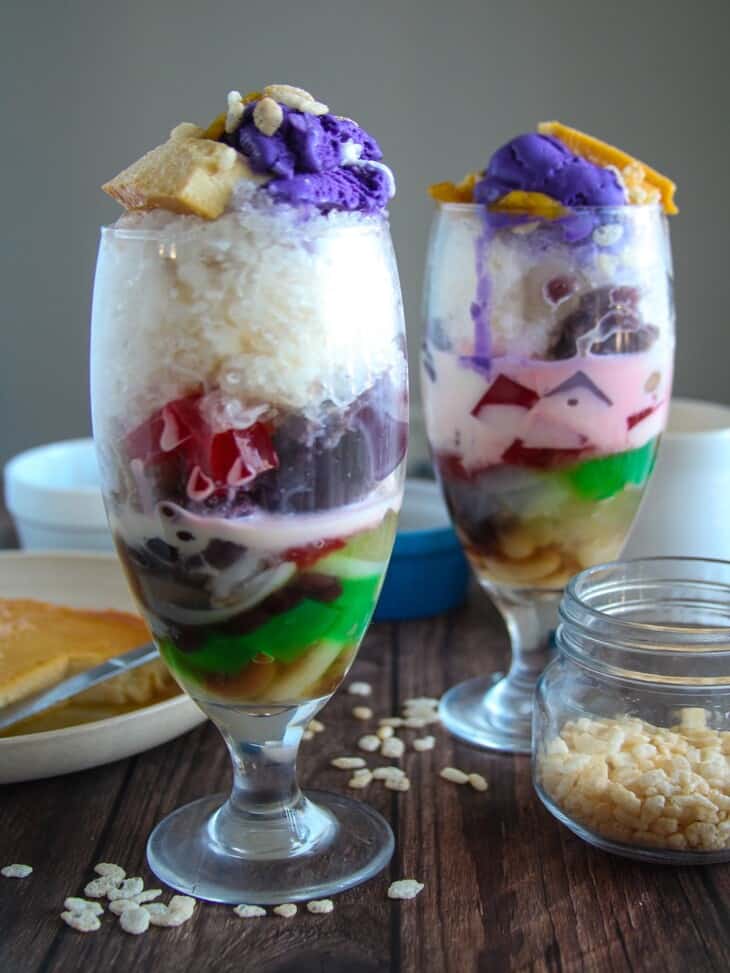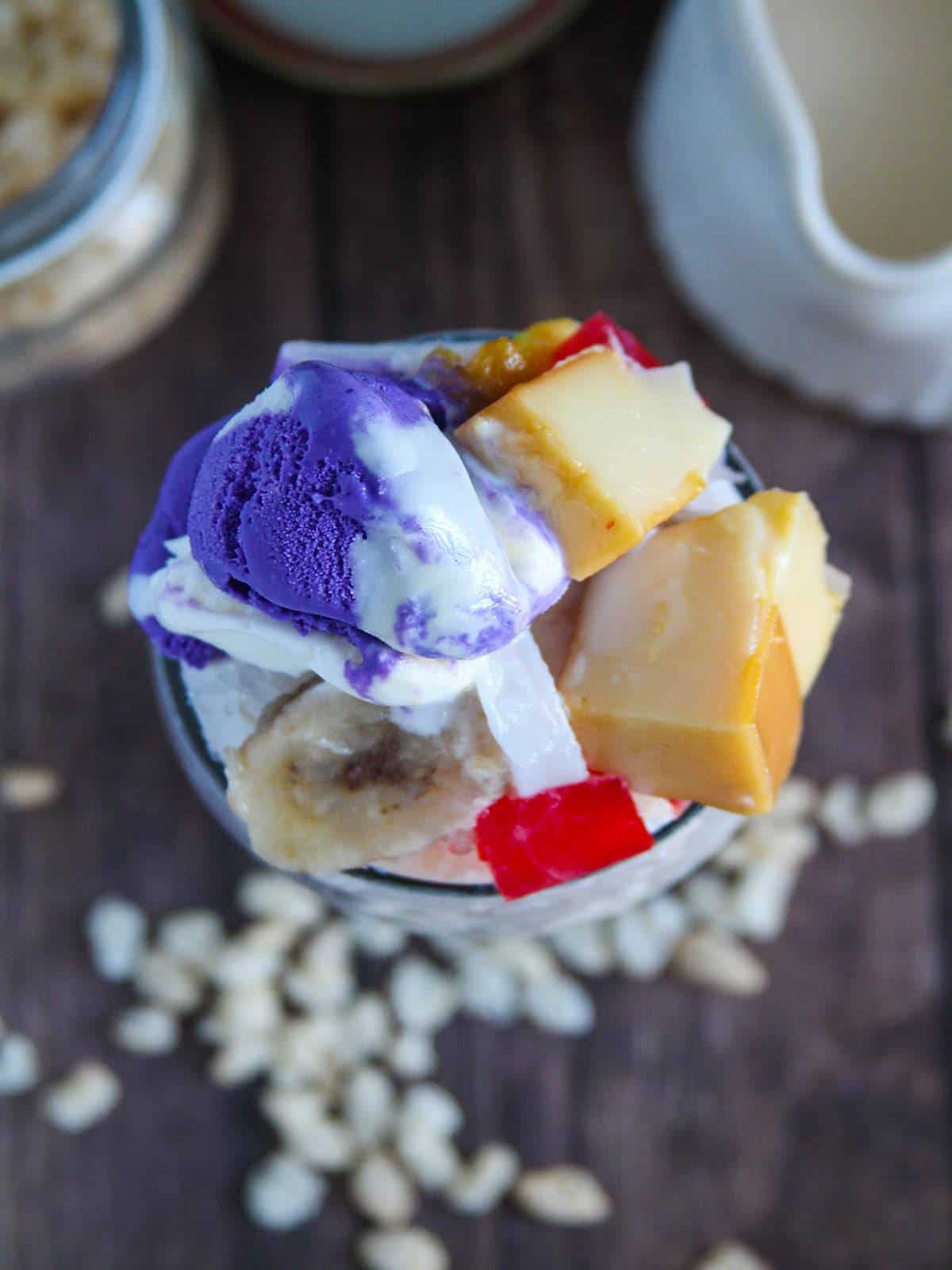Halo Halo - A Sweet Philippine Delight
Imagine a delightful sweet treat from the Philippines, a chilled concoction that many people adore. This layered wonder, known as halo halo, offers a truly unique experience, especially when the weather turns warm. It's a dessert that, in some respects, brings a little bit of joy and refreshment to anyone who tries it, truly a favorite across the islands.
This cooling creation is built around a generous mound of finely shaved frozen water, then bathed in a rich, creamy dairy liquid, sometimes evaporated milk, sometimes a lighter, tropical coconut milk. On top of that, you get a whole collection of different sweet bits and pieces, sort of like little sweet surprises. One of the most beloved of these, it's almost a must-have, is a vibrant purple yam spread, known as ube jam or ube halaya.
What you get with halo halo is a vibrant display of colors and a fascinating mix of textures, all combined into one single serving. It’s a treat that feels both simple and wonderfully complex at the same time. Many people consider this concoction to be, you know, the unofficial national sweet dish of the Philippines, and for good reason, as a matter of fact.
Table of Contents
- What Makes Halo Halo So Special?
- The Core Elements of Halo Halo
- Beyond the Basics - Unique Halo Halo Additions
- How Did Halo Halo Become a National Treasure?
- A Brief History of Halo Halo
- Where Can You Enjoy the Best Halo Halo?
- Crafting Your Own Halo Halo at Home
- Why is Halo Halo More Than Just a Dessert?
What Makes Halo Halo So Special?
So, what makes this particular sweet creation stand out from other chilled desserts around the globe? It’s arguably the way it brings together so many different tastes and feels in one glass. You get the cool sensation from the ice, the creamy coating from the milk, and then a playful variety of soft, chewy, and sometimes slightly crunchy elements. It’s a very dynamic experience for your taste buds, truly. Each spoonful can be a little bit different, offering a new combination of flavors and textures, which is part of its charm. You might pick up on the sweetness of a fruit, the earthy taste of a bean, or the distinct flavor of that purple yam. This mixture of components is what really sets halo halo apart, making it a treat that keeps you interested from the first bite to the last, as a matter of fact.
The Core Elements of Halo Halo
At its heart, any good halo halo begins with a generous helping of finely shaved ice, which forms the base of this delightful creation. This isn't just any ice; it's typically shaved so thin that it feels almost like snow, ready to melt in your mouth and provide that instant cooling sensation. Over this icy foundation, a pour of rich, creamy milk is added. Usually, this is evaporated milk, which gives the dessert a wonderful depth and a comforting, milky taste. Sometimes, though, you might find versions that use coconut milk, which lends a slightly different, more tropical taste to the whole thing. These two elements, the snow-like ice and the smooth milk, are, you know, the true starting point for building this wonderful sweet dish. They create the cool, creamy canvas upon which all the other delightful bits and pieces are arranged, making the halo halo experience what it is, really.
Beyond the Basics - Unique Halo Halo Additions
Now, this is where the halo halo really starts to get interesting, because the beauty of it lies in its incredible variety of added components. While the purple yam spread, ube halaya, is a very popular and almost iconic inclusion, it's just one of many possibilities. You might find spoonfuls of sweet beans, like red mung beans or white kidney beans, which add a delightful chewiness and a gentle, earthy sweetness. Then there are the fruits, perhaps slices of sweet plantain, known as saba, or sometimes jackfruit, offering a burst of natural fruitiness. You could also discover cubes of colorful jellies, often made from agar-agar or gelatin, providing a playful, wobbly texture. Some versions even include small pieces of flan, a rich custard, which adds a luxurious, creamy element. There are also often little tapioca pearls, called sago, and green jelly noodles, known as gulaman, which contribute to the varied textures. Really, the combination of these different bits and pieces is what makes each halo halo a slightly different adventure, and that’s part of its charm, actually.
How Did Halo Halo Become a National Treasure?
It’s a bit of a wonder, isn't it, how a simple sweet dish can become so deeply woven into the fabric of a nation’s culture? For halo halo, its rise to becoming, you know, the unofficial national sweet treat of the Philippines, is tied to its perfect suitability for the country's warm climate. When the sun is shining brightly and the air is humid, a cold, refreshing item like this is just what people crave. It offers instant relief and a moment of sweet pleasure. But it's more than just a way to cool down; it’s also a dish that embodies a sense of community and shared enjoyment. Families and friends often gather to share a serving, or to make it together, picking their favorite additions. This communal aspect, combined with its widespread availability and its appealing mix of flavors, has cemented its place in the hearts of many Filipinos. It’s a very comforting and familiar presence, you know, in daily life and during celebrations, too.
A Brief History of Halo Halo
The origins of halo halo are, in some respects, quite fascinating and tell a story of cultural mixing. While it feels distinctly Filipino now, its roots can actually be traced back to Japanese influences, specifically a dessert called "kakigori," which is shaved ice with sweet toppings. During the early 20th century, Japanese migrants in the Philippines introduced their version of this chilled treat, using local ingredients that were readily available. Over time, Filipinos adapted it, adding their own unique sweet components and preferences, leading to the layered, colorful creation we recognize today. The name itself, "halo halo," means "mix-mix" in Tagalog, which perfectly describes the way you're meant to enjoy it – by stirring all those wonderful ingredients together. This evolution from a borrowed idea to a truly unique and beloved local specialty shows how cultures can blend and create something entirely new and wonderful. It's a testament to how food traditions can change and grow, really, over the years.
Where Can You Enjoy the Best Halo Halo?
If you're wondering where to find a truly memorable halo halo, the good news is that this sweet concoction is pretty much everywhere in the Philippines. You can find it in busy street stalls, where vendors skillfully shave ice and assemble glasses right before your eyes. These spots often offer a very authentic and immediate experience, with the flavors being quite robust and traditional. Then there are the local eateries, often called carinderias, which serve home-style meals and typically have their own version of this dessert, too. Even in more modern restaurants and fast-food chains, you’ll find halo halo on the menu, sometimes with a slightly refined presentation or a few unique additions. Each place might have its own special touch, perhaps a secret ingredient or a particular way of layering things, so it’s worth trying different spots to see what you like best. It’s almost a little adventure, trying to find your favorite version, isn't it?
Crafting Your Own Halo Halo at Home
Making your own halo halo at home is actually a pretty straightforward and enjoyable process, and it allows for a lot of creative freedom. You'll need a way to make finely shaved ice; a dedicated ice shaver works best, but a blender can do the trick if you're careful. Then, gather your preferred sweet additions. Think about that wonderful ube jam, sweet beans, maybe some fruit slices like ripe plantain or jackfruit, and perhaps some chewy jellies. Don't forget the creamy element – evaporated milk is the usual choice, but coconut milk is also a very good option for a different flavor profile. The key is to layer everything. Start with a few spoonfuls of your chosen ingredients at the bottom of a tall glass, then pile on the shaved ice. Pour a generous amount of milk over the ice, and then add a few more toppings on top for a visually appealing finish. The real fun begins when you mix it all together, allowing the flavors and textures to meld into one delicious, chilled experience. It’s a very satisfying thing to create, really, and then to enjoy, too.
Why is Halo Halo More Than Just a Dessert?
For many people, halo halo is much more than just a sweet treat to enjoy on a warm day; it’s a symbol of comfort, memory, and connection. It brings back childhood recollections for some, of summer afternoons spent with family or friends. It’s a dish that’s often shared, prompting conversation and laughter as everyone digs into their colorful glass. The act of mixing all the components together, which is what the name "halo halo" literally means, can be seen as a playful representation of how different elements come together to create something wonderful. It’s a very communal experience, you know. This sweet concoction has a way of evoking a feeling of home and a sense of belonging, making it a truly cherished part of the culture. It's a little bit of happiness in a glass, really, a simple pleasure that carries a lot of meaning for those who love it, as a matter of fact.
This exploration has covered halo halo, a popular cold dessert from the Philippines. We looked at its core ingredients, such as crushed ice and milk, and discussed the various sweet additions like ube jam. The article touched upon its status as an unofficial national dessert and its refreshing qualities. It also explored how the different components combine to create a layered, colorful, and textural sweet dish.

HALO-HALO: List Of Usual Ingredients In Making Halo-Halo

Halo-Halo (Filipino Shaved Ice Dessert) - Kawaling Pinoy

Halo-Halo (Filipino Shaved Ice Dessert) - Kawaling Pinoy